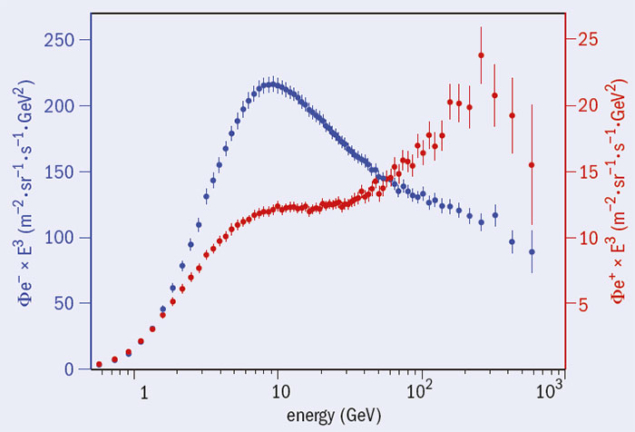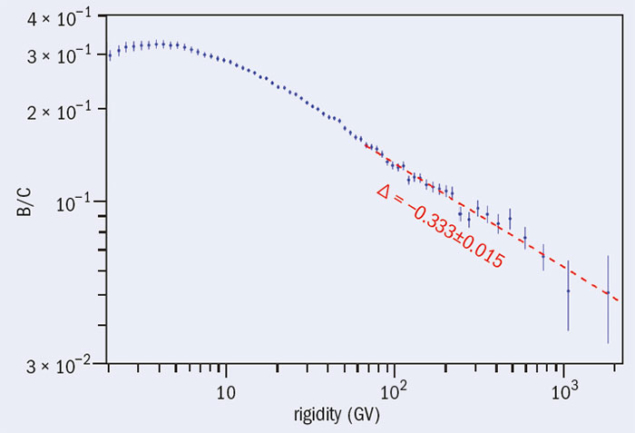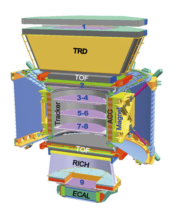Five years of data from the AMS experiment on board the International Space Station reveal intriguing features.

Image credit: NASA.
The International Space Station (ISS) is the largest and most complex engineering project ever built in space. It has also provided a unique platform from which to conduct the physics mission of the Alpha Magnetic Spectrometer (AMS). Over the past five years on board the ISS, AMS has orbited the Earth every 93 minutes at an altitude of 400 km and recorded 85 billion cosmic-ray events with energies reaching the multi-TeV range. AMS has been collecting its unprecedented data set and beaming it down to CERN since 2011, and is expected to continue to do so for the lifetime of the ISS.
AMS is a unique experiment in particle physics. The idea for a space-based detector developed after the cancellation of the Superconducting Super Collider in the US in 1993. The following year, an international group of physicists who had worked together for many years at CERN’s LEP collider had a discussion with Roald Sagdeev, former director of the Soviet Institute of Space Research, about the possibility of performing a precision particle-physics experiment in space. Sagdeev arranged for the team to meet with Daniel Goldin, the administrator of NASA, and in May 1994 the AMS collaboration presented the science case for AMS at NASA’s headquarters. Goldin advised the group that use of the ISS as a platform required strong scientific endorsement from the US Department of Energy (DOE) and, after the completion of a detailed technical review of AMS science, the DOE and NASA formalised responsibilities for AMS deployment on the ISS on 20 September 1995.
A 10 day precursor flight of AMS (AMS-01) was carried out in June 1998, demonstrating for the first time the viability of using a precision, large-acceptance magnetic spectrometer in space for a multi-year mission. The construction of AMS-02 for the ISS started immediately afterwards in collaborating institutes around the world. With the loss of the shuttle Columbia in 2003 and the resulting redirection of space policy, AMS was removed from the space-shuttle programme in October 2005. However, the importance of performing fundamental science on the ISS was widely recognised and supported by the NASA Space Station management under the leadership of William Gerstenmaier. In 2008, the US Congress unanimously agreed that AMS be reinstated, mandating an additional flight for the shuttle Endeavour with AMS as its prime payload. Shortly after installation on the ISS in May 2011, AMS was powered on and began collecting and transmitting data (CERN Courier July/August 2011 p18).
The first five years
Much has been learnt in the first five years of AMS about operating a particle-physics detector in space, especially the challenges presented by the ever changing thermal environment and the need to monitor the detector elements and electronics 24 hours per day, 365 days per year. Communications with NASA’s ISS Mission Control Centers are also an essential requirement to ensure the operations of the ISS – such as sudden, unscheduled power cuts and attitude changes – do not disrupt the operations of AMS or imperil the detector.

Of course, it is the data recorded by AMS from events in the distant universe that are the most rich scientifically. AMS is able to detect both elementary particles – namely electrons, positrons, protons and antiprotons – in addition to nuclei of helium, lithium and heavier elements up to indium. The large acceptance and multiple redundant measurements allow AMS to analyse the data to an accuracy of approximately 1%. Combined with its atmosphere-free window on the cosmos, its long-duration exposure time and its extensive calibration at the CERN test beam, this allows AMS to greatly improve the accuracy of previous charged cosmic-ray observations. This is opening up new avenues through which to investigate the nature of dark matter, the existence of heavy antimatter and the true properties of primordial cosmic rays.
The importance of precision studies of positrons and antiprotons as a means to search for the origin of dark matter was first pointed out by theorists John Ellis and, independently, by Michael Turner and Frank Wilczek. They noted that annihilations of the leading dark-matter candidate, neutralinos, produce energies that transform neutralinos into ordinary particles such as positrons and antiprotons. Crucially, this characteristic excess of positrons and antiprotons in cosmic rays can be measured. The characteristic signature of dark-matter annihilations is a sharp drop-off of these positron and antiproton excesses at high energies, due to the finite mass of the colliding neutralinos. In addition, since dark matter is ubiquitous, the excesses of the fluxes should be isotropic.
Early low-energy measurements by balloons and satellites indicated that both the positron fraction (that is, the ratio of the positron flux to the flux of electrons and positrons) and the antiproton-to-proton fluxes are larger than predicted by models based on the collisions of cosmic rays. The superior precision of AMS over previous experiments is now allowing researchers to investigate such features, in particular the drop-off in the positron and antiproton excesses, in unprecedented detail.

The first major result from AMS came in 2013 and concerned the positron fraction (CERN Courier October 2013 p22). This highly accurate result showed that, up to a positron energy of 350 GeV, the positron fraction fits well to dark-matter models. This result generated widespread interest in the community and motivated many new interpretations of the positron-fraction excess, for instance whether it is due to astrophysical sources or propagation effects. In 2014, AMS published the positron and electron fluxes, which showed that their behaviours are quite different from each other and that neither can be fitted with the single-power-law assumption underpinning the traditional understanding of cosmic rays.
A deepening mystery
The latest AMS results are based on 17.6 million electrons and positrons and 350,000 antiprotons. In line with previous AMS measurements, the positron flux exhibits a distinct difference from the electron flux, both in its magnitude and energy dependence (figure 1). The positrons show a unique feature: they have a tendency to drop-off sharply at energies above 300 GeV, as expected from dark-matter collisions or new astrophysical phenomena. The positron fraction decreases with energy and reaches a minimum at 8 GeV. It then increases with energy and rapidly exceeds the predictions from cosmic-ray collisions, reaching a maximum at 265 GeV and then beginning to fall off. Whereas neither the electron flux nor the positron flux can be described by a single power law, surprisingly the sum of the electron and positron fluxes can be described very accurately by a single power law above an energy of 30 GeV.
Since astrophysical sources of cosmic-ray positrons and electrons may induce some degree of anisotropy in their arrival directions, it is also important to measure the anisotropy of cosmic-ray events recorded by AMS. Using the latest data set, a systematic search for anisotropies has been carried out on the electron and positron samples in the energy range 16–350 GeV. The dipole-anisotropy amplitudes measured on 82,000 positrons and 1.1 million electrons are 0.014 for positrons and 0.003 for electrons, which are consistent with the expectations from isotropy.
The latest AMS results on the fluxes and flux ratio of electrons and positrons exhibit unique and previously unobserved features. These include the energy dependence of the positron fraction, the existence of a maximum at 265 GeV in the positron fraction, the exact behaviour of the electron and positron fluxes and, in particular, the sharp drop-off of the positron flux. These features require accurate theoretical interpretation as to their origin, be it from dark-matter collisions or new astrophysical sources.

Concerning the measured antiproton-to-proton flux ratio (figure 2), the new data show that this ratio is independent of rigidity (defined as the momentum per unit charge) in the rigidity range 60–450 GV. This is contrary to traditional cosmic-ray models, which assume that antiprotons are produced only in the collisions of cosmic rays and therefore that the ratio decreases with rigidity. In addition, due to the large mass of antiprotons, the observed excess of the antiproton-to-proton flux ratio cannot come from pulsars. Indeed, the excess is consistent with some of the latest model predictions based on dark-matter collisions as well as those based on new astrophysical sources. Unexpectedly, the antiproton-to-positron flux ratio is also independent of rigidity in the range 60–450 GV (CERN Courier October 2016 p8). This is considered as a major result from the five-year summary of AMS data.
The upshot of these new findings in elementary-particle cosmic rays is that the rigidity dependences of the fluxes of positrons, protons and antiprotons are nearly identical, whereas the electron flux has a distinctly different rigidity dependence. This is unexpected because electrons and positrons lose much more energy in the galactic magnetic fields than do protons and antiprotons.
Nuclei in cosmic rays
Most of the cosmic rays flying through the cosmos comprise protons and nuclei, and AMS collects nuclei simultaneously with elementary particles to enable an accurate understanding of both astrophysical phenomena and cosmic-ray propagation. The latest AMS results shed light on the properties of protons, helium, lithium and heavier nuclei in the periodic table. Protons, helium, carbon and oxygen are traditionally assumed to be primary cosmic rays, which means they are produced directly from a source such as supernova remnants.
Protons and helium are the two most abundant charged cosmic rays. They have been measured repeatedly by many experiments over many decades, and their energy dependence has traditionally been assumed to follow a single power law. In the case of lithium, which is assumed to be produced from the collision of primary cosmic rays with the interstellar medium and therefore yields a single power law but with a different spectral index, experimental data have been very limited.
No one has a clue what could be causing these spectacular effects
Sam Ting
The latest AMS data reveal, with approximately 1% accuracy, that the proton, helium and lithium fluxes as a function of rigidity all deviate from the traditional single-power-law dependence at a rigidity of about 300 GV (figure 3). It is completely unexpected that all three deviate from a single power law, that all three deviations occur at about the same rigidity and increase at higher rigidities, and that the three spectra can be fitted with double power laws above a rigidity of 45 GV. In addition, it has long been assumed that since both protons and helium are primary cosmic rays with the same energy dependence at high energies, their flux ratio would be independent of rigidity. The AMS data show that above rigidities of 45 GV, the flux ratio decreases with rigidity and follows a single-power-law behaviour. Despite being a secondary cosmic ray, lithium also exhibits the same rigidity behaviour as protons and helium. It is fair to say that, so far, no one has a clue what could be causing these spectacular effects.

The latest AMS measurement of the boron-to-carbon flux ratio (B/C) also contains surprises (figure 4). Boron is assumed to be produced through the interactions of primary cosmic rays such as carbon and oxygen with the interstellar medium, which means that B/C provides information both on cosmic-ray propagation and on the properties of the interstellar medium. The B/C ratio does not show any significant structures, in contrast to many cosmic-ray propagation models that assume such behaviour at high rigidities (including a class of propagation models that explain the observed AMS positron fraction). Cosmic-ray propagation is commonly modelled as relativistic gas diffusion through a magnetised plasma, and models of the magnetised plasma predict different behaviours of B/C as a function of rigidity. At rigidities above 65 GV, the latest AMS data can be well fitted by a single power law with spectral index Δ in agreement with the Kolmogorov model of turbulence, which predicts Δ = –1/3 asymptotically.
Building a spectrometer in space
AMS is a precision, multipurpose TeV spectrometer measuring 5 × 4 × 3 m and weighing 7.5 tonnes. It consists of a transition radiation detector (TRD) to identify electrons and positrons; a permanent magnet together with nine layers of silicon tracker (labelled 1 to 9) to measure momentum up to the multi-TeV range and to identify different species of particles and nuclei via their energy loss; two banks of time-of-flight (TOF) counters to measure the direction and velocity of cosmic rays and identify species by energy loss; veto counters (ACC) surrounding the inner bore of the magnet to reject cosmic rays from the side; a ring-image Cherenkov counter (RICH) to measure the cosmic-ray energy and identify particle species; and an electromagnetic calorimeter (ECAL) to provide 3D measurements of the energy and direction of electrons and positrons, and distinguish them from antiprotons, protons and other nuclei.
Future directions
Much has been learnt from the unexpected physics results from the first five years of AMS. Measuring many different species of charged cosmic rays at the same time with high accuracy provides unique input for the development of a comprehensive theory of cosmic rays, which have puzzled researchers for a century. AMS data are also providing new information that is essential to our understanding of the origin of dark matter, the existence of heavy antimatter, and the properties of charged cosmic rays in the cosmos.
The physics potential of AMS is the reason why the experiment receives continuous support. AMS is a US DOE and NASA-sponsored international collaboration and was built with European participation from Finland, France, Germany, Italy, Portugal, Spain and Switzerland, together with China, Korea, Mexico, Russia, Taiwan and the US. CERN has provided critical support to AMS, with CERN engineers engaged in all phases of the construction. Of particular importance was the extensive calibration of the AMS detector with different particle test beams at various energies, which provided key reference points for verifying the detector’s operation in space.
AMS will continue to collect data at higher energies and with high precision during the lifetime of the ISS, at least until 2024. To date, AMS is the only long-duration precision magnetic spectrometer in space and, given the challenges involved in such a mission, it is likely that it will remain so for the foreseeable future.






